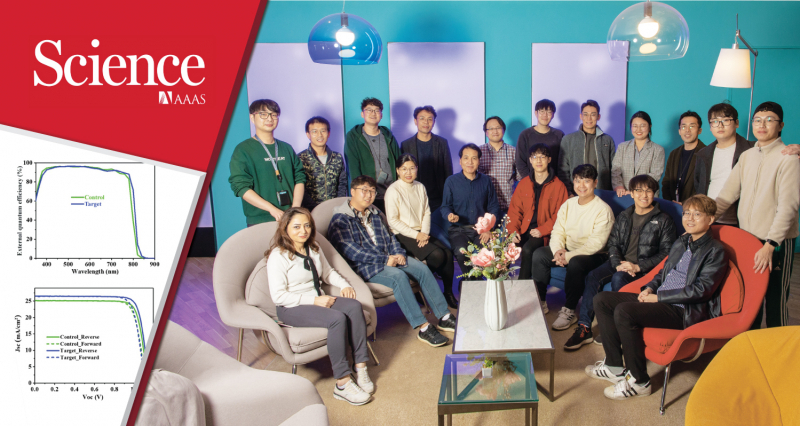Adding a small amount of other metals to iron that is soft and rusts easily, could result in sturdy and rust resistant stainless steel. Likewise, a technology has been developed to capture the shortcomings of peroveskite. The commercialization of perovskite solar cells, which have been attracted much attention as the next-generation solar cells, could be accelerated.
A research team, led by Distinguished Professor Sang Il Seok in the School of Energy and Chemical Engineering at UNIST, has engineered the light-absorbing layer material with the new composition of perovskite material and applied it to the solar cell. By simply changing their additives, the new material has significantly increased both efficiency and stability of the existing perovskite solar cells.
Perovskite solar cells are made of a mixture of organic molecules and inorganic elements within a single crystalline structure that is inexpensive and easy to produce in the lab via low-temperature solution process. For this reason, PSCs have emerged as a promising candidate for the next generation solar technology, following silicon-based solar cells.
The core to solar cells is the photoactive layer, which absorbs sunlight directly to generate electric current. Thus, how strong and stable (durability) this layer gets and how efficiently it converts light into electricity are what determines the commercialization. With the perovskite solar cells, a material having a perovskite crystal structure is used as the photoactive layer, thus enhancing the efficiency and stability of this layer is an eminently important task for commercialization.
The efficiency of this photoactive layer is determined by the band gap, the energy structure of electrons in matter atoms. The narrower the band gap, the wider the wavelength bands of solar radiation. Therefore, it is important to narrow the band gap of the perovskite material, which acts as the photoactive layer. However, in case of conventional photoactive layers, materials such as Methylammonium (MA) and bromine (Br), which prevent the structural changes, widened the band gap. In other words, the attempt to maintain the stability of the perovskite crystal structure has resulted in low efficiency in the photoactive layer. Besides, in case of MA, the durability of photoactive layer was lowered.
Professor Seok and his team added divalent organic cations (i.e., methylenediammonium, MDA) in place of Br and MA. Those new additives stabilize the crystal structure and maintain its efficiency, which simultaneously captures the stability and efficiency of the photoactive layer.

Figure 1. Long-term stability test. Comparison of (A) humidity (85% RH, 25°C) and (B) thermal (150°C at ~25% RH) stability performances of unencapsulated control and target. (C) Maximum power point tracking measured with the encapsulated target device under full solar illumination (AM 1.5 G, 100 mW/cm2 in ambient conditions) without a UV filter.
“This study led to a good result of attempting to break the stereotype that the material added mainly for the durability of the perovskite material was a monovalent cation,” says Hanul Min in the Combined M.S/Ph.D. of Energy and Chemical Engineering at UNIST, the first author of the study. “The efficiency of the perovskite containing the divalent organic cation was 23.7%, and it operated more than 90% stably even after 600 hours of operation in an environment in which sunlight was radiated.”
Professor Seok’s team is known for being the world-leading experts in the field of perovskite solar cells. They broke the 20% efficiency barrier for perovskite solar cells for the first time in history, thus have updated the record four times. Besides, Professor Seok has published five papers on perovskite solar cells in the journal, Science.

Figure 2. Comparison of (A) I–V curves and (B) external quantum efficiency between target (x = 0.38 mol %) and control.
This study broadens the solar-light absorption wavelength band with new composition that is completely different from the existing ones. This has greatly improved humidity-, thermal-, and photostability performances, while increasing photocurrent density to the world’s highest.
This research has been carried out through the support of the National Research Foundation of Korea (NRF) funded by the Korean government (MSIT), the Global Frontier R&D Program on Centre for Multiscale Energy System, and by the U-K Brand research fund.
Journal Reference
Hanul Min, et al., “Efficient, stable solar cells by using inherent bandgap of α-phase formamidinium lead iodide,” Science, (2019).












